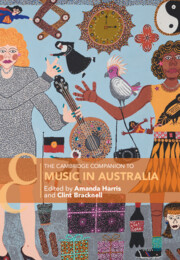Book contents
- The Cambridge Companion to Music in Australia
- Cambridge Companions to Music
- The Cambridge Companion to Music in Australia
- Copyright page
- Dedication
- Contents
- Figures
- Maps
- Tables
- Music Examples
- Contributors
- Acknowledgements
- 1 Introduction and Historiography of Music in Australia
- Part I Continuities
- Part II Encounters
- 6 Cultivating a European Concert Culture in Colonial Sydney and Hobart, 1826–1840
- 7 An Early Australian Musical Modernism
- 8 Country Music: Australianising an American Tradition?
- 9 The Development of the Australian Pop Charts and the Changing Meaning of the ‘Number One’ Single
- 10 Artist Perspective Didjeridu on the Art Music Stage
- Part III Diversities
- Part IV Institutions
- Index
- References
9 - The Development of the Australian Pop Charts and the Changing Meaning of the ‘Number One’ Single
from Part II - Encounters
Published online by Cambridge University Press: 14 November 2024
- The Cambridge Companion to Music in Australia
- Cambridge Companions to Music
- The Cambridge Companion to Music in Australia
- Copyright page
- Dedication
- Contents
- Figures
- Maps
- Tables
- Music Examples
- Contributors
- Acknowledgements
- 1 Introduction and Historiography of Music in Australia
- Part I Continuities
- Part II Encounters
- 6 Cultivating a European Concert Culture in Colonial Sydney and Hobart, 1826–1840
- 7 An Early Australian Musical Modernism
- 8 Country Music: Australianising an American Tradition?
- 9 The Development of the Australian Pop Charts and the Changing Meaning of the ‘Number One’ Single
- 10 Artist Perspective Didjeridu on the Art Music Stage
- Part III Diversities
- Part IV Institutions
- Index
- References
Summary
This chapter explores the history and present of the singles charts, and the phenomenon of the number one single, in a specifically Australian context. The history of the Australian singles charts are explored, from their beginnings in Go-Set magazine in 1966, based on sales of physical product, to the present-day situation, where the ARIA singles charts are primarily based on listens on streaming services. The chapter goes on to discuss the ways in which these differing consumption methods over the years affects the composition of the charts. While the charts in Australia often reflect overseas success by international artists, the particular music industry ecosystem in Australia can affect the success of different music.Similarly, the number one singles by Australian artists from the last decade are discussed, suggesting that it is increasingly difficult to have Australian chart success without international success.
Keywords
- Type
- Chapter
- Information
- The Cambridge Companion to Music in Australia , pp. 148 - 161Publisher: Cambridge University PressPrint publication year: 2024

